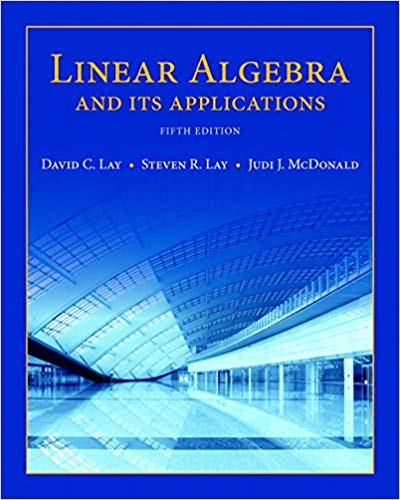
Linear Algebra and Its Applications, 5th Edition
Authors: David C. Lay, Steven R. Lay, Judi J. McDonald
ISBN-13: 978-0321982384
We have solutions for your book!
See our solution for Question 18E from Chapter 6.1 from Lay's Linear Algebra and Its Applications, 5th Edition.
Problem 18E
Chapter:
Problem:
Determine which pairs of vectors in Exercises 15–18 are orthogonal.
Step-by-Step Solution
Given Information
We are given with following matrices: \[ \mathbf { y } = \left[ \begin{array} { c } { - 3 } \\ { 7 } \\ { 4 } \\ { 0 } \end{array} \right] \text { and } \mathbf { z } = \left[ \begin{array} { c } { 1 } \\ { - 8 } \\ { 15 } \\ { - 7 } \end{array} \right] \] We have to find whether the following vectors are orthogonal or not.
Step-1: Find the Product of vectors
\[\begin{array}{l} {\bf{y}}\cdot{\bf{z}} = \left[ {\begin{array}{*{20}{c}} { - 3}\\ 7\\ 4\\ 0 \end{array}} \right]\left[ {\begin{array}{*{20}{c}} 1\\ { - 8}\\ {15}\\ { - 7} \end{array}} \right]\\ = \left[ {\begin{array}{*{20}{c}} { - 3}&7&4&0 \end{array}} \right]\left[ {\begin{array}{*{20}{c}} 1\\ { - 8}\\ {15}\\ { - 7} \end{array}} \right]\\ = ( - 3)(1) + (7)( - 8) + (4)(15) + (0)( - 7)\\ = - 3 - 56 + 60 + 0\\ = 1 \end{array}\] Therefore,
The vectors are not orthogonal
We are given with following matrices: \[ \mathbf { y } = \left[ \begin{array} { c } { - 3 } \\ { 7 } \\ { 4 } \\ { 0 } \end{array} \right] \text { and } \mathbf { z } = \left[ \begin{array} { c } { 1 } \\ { - 8 } \\ { 15 } \\ { - 7 } \end{array} \right] \] We have to find whether the following vectors are orthogonal or not.
Step-1: Find the Product of vectors
\[\begin{array}{l} {\bf{y}}\cdot{\bf{z}} = \left[ {\begin{array}{*{20}{c}} { - 3}\\ 7\\ 4\\ 0 \end{array}} \right]\left[ {\begin{array}{*{20}{c}} 1\\ { - 8}\\ {15}\\ { - 7} \end{array}} \right]\\ = \left[ {\begin{array}{*{20}{c}} { - 3}&7&4&0 \end{array}} \right]\left[ {\begin{array}{*{20}{c}} 1\\ { - 8}\\ {15}\\ { - 7} \end{array}} \right]\\ = ( - 3)(1) + (7)( - 8) + (4)(15) + (0)( - 7)\\ = - 3 - 56 + 60 + 0\\ = 1 \end{array}\] Therefore,
The vectors are not orthogonal